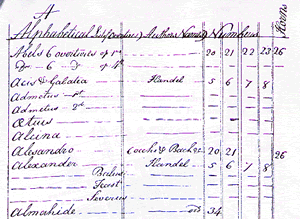The Musical Society of Edinburgh
The Musical Society of Edinburgh (1728-1801)
The Musical Society of Edinburgh moulded the musical life of the nobility and gentry of Scotland, many of whom were accomplished amateur musicians who often indulged in chamber music or even public performances.
Under the auspices of the Society, who engaged singers and players of European fame, weekly concerts were given to an exclusive audience of regular subscribers, from its formal inauguration in 1728 in the upper room of St Mary’s Chapel, Niddry Wynd , and after 1763 in the purpose-built oval room of St. Cecilia’s Hall nearby.
The Society owned a valuable library of sheet music and a collection of musical instruments.
Like many other fashionable institutions, it was not devoid of charitable intentions. Thus, £40 were raised in a concert given in 1739 on behalf of the Infirmary, for which tickets had been sold at half a crown each.
The migration of Edinburgh’s upper classes from the Old Town to the New Town after the building of the new Assembly Rooms in 1787 marked the decline of the Musical Society. Concerts ended in 1798, and the Society was disbanded in 1801.
Music performed for the Edinburgh Musical Society
The repertoire of music performed and sung for the weekly concerts of the Edinburgh Musical Society between 1723 and 1797 included many choral works by Handel, two or three of whose oratorios would be played every year, as well as concertos and sonatas by Corelli and many other Italian composers such as Bassani or Geminiani, symphonies of Haydn, and early works of Beethoven. In other words, the music played in Edinburgh in the eighteenth-century was nearly always imported.
It is worth noting that a public concert of Handel’s Alexander’s Feast comprised 40 choristers and 30 other performers in 1768. In the audience, there sat 440 ladies, 80 members, and 50 “stranger gentlemen”.
However, Robert Chambers quoted the recollections of George Thomson, who died in 1851, aged 94. The latter mentioned not only classical music by such composers as Haydn, but also “simple melodies of Scotland” being performed in St. Cecilia’s Hall (Traditions of Edinburgh, 2nd ed.?, 1868, 272-9).
Membership of the Edinburgh Musical Society
In the early history of the Edinburgh Musical Society, the annual subscription amounted to one guinea, but it was later increased to one and a half guineas, then two guineas. As Edward Topham noted, this ensured that “none [were] admitted but the people of fashion” (Letters from Edinburgh, 1776, p. 377).
Indeed, a list of members for 1775 included 156 names, including 4 Dukes, 14 Earls, 9 baronets and 3 barons, 7 “Lords”, and 81 “Esq.”, shows that the nobility and the gentry were particularly influential in the Edinburgh musical society. (David Fraser Harris, Saint Cecilia’s Hall…, 1899, 290-9).
The Library belonging to the Edinburgh Musical Society

- St Cecilia’s Hall (1899)
- from David Fraser Harris
[click on the picture to enlarge it]
As the facsimile page from the index of the music belonging to the Edinburgh Musical Society (1782) shows, Handel, who had accepted to let the Society have full copies of all his manuscript oratorios, took pride of place in their repertoire, which also included works by other English composers, such as Arne, but also mirrored the taste of eighteenth-century British audiences for Italian music.
Musical instruments in the Edinburgh Musical Society
The organ mentioned by the city historian Hugo Arnot in his description of the oval room must have been the instrument ordered from John Snetzler in 1766, at £150, and eventually delivered in 1775.
Before the move to the oval room in 1763, the Society owned approximately twenty other musical instruments, which could form a typical baroque orchestra:
- a harpsichord and an organ, presumably for the continuo
- 5 string instruments (2 double basses, 2 “tenor fiddles,” and 1 cello)
- 9 wind instruments (2 French horns “with crooks”, 2 oboes, 1 German flute, 2 “octave German flutes”, and 2 flageolets)
- [not to mention the 3 bassoons, one of which could assist with the continuo]
- and two kettledrums.

